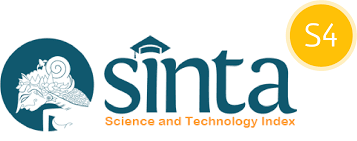Penerapan K-Means Clustering Dalam Pengelompokan Prestasi Siswa Dengan Optimasi Metode Elbow
DOI:
https://doi.org/10.29408/jit.v7i2.26375Keywords:
Clustering, Data Mining, K-Means, Elbow, Prestasi Siswa, Student Archievment, SchoolAbstract
Student achievement is very important and meaningful in the world of education, this picture can be seen from the grouping of classrooms, determining talents and interests as well as the level of ability and willingness of students according to the abilities of each individual. This is why researchers conducted research at MIS NW 03 Pancor with data from class 4 as many as 23 students, class 5 as many as 27 students, and class 6 as many as 25 students which were related to variables in student learning achievement. In determining this matter, the school still uses conventional decision-making methods, so it is still difficult to determine student achievement according to their abilities. Thus, schools need to make changes that can help employees and institutions improve education quality by knowing student learning achievements. As for this problem, the author provides a solution that requires a calculation system with the concept of data mining. Mastery of learning material is one of the benchmarks for obtaining student grades and this is one of the policies in determining student achievement. Apart from grades, there are also attitudes and skills which are factors in determining student achievement at school. This can be solved with one of the techniques in data mining that can be used for grouping, namely clustering. The results of this research are a system that can make it easier for schools to quickly and accurately group student achievement using k-means which is optimized using the elbow method with the results obtained, namely cluster 1 "good" with 9 students, cluster 2 "very good" with 6 students, cluster 3 is "fairly good" as many as 8 students and the Davies Bouldin value is 0.711 and the AVG within centroid distance is 18.821 so it can help the school in determining student achievement groups
References
A. Nurjana, A. Perdana Windarto, and H. Qurniawan, “Implementasi Data Mining Dalam Memprediksi Prestasi Siswa Dengan Algoritma C4.5,” SmartEDU, vol. 1, pp. 171–180, 2022, [Online]. Available: https://ejournal.abivasi.id/index.php/SmartEDU
A. Sulistiyawati and E. Supriyanto, “Implementasi Algoritma K-means Clustring dalam Penetuan Siswa Kelas Unggulan,” Jurnal Tekno Kompak, vol. 15, no. 2, pp. 25-36, 2021
A. M. Nur, N. Nurhidayati, and I. Fathurrahman, “Penerapan Metode Naïve Bayes Untuk Penentuan Penerima Beasiswa Program Indonesia Pintar (PIP).,” Infotek: Jurnal Informatika dan Teknologi, vol. 7, no. 1, pp. 93–102, Jan. 2024, doi: 10.29408/jit.v7i1.23995
R. Yuliani, “Penerapan Data Mining untuk Mengcluster Data Penduduk Miskin Menggunakan Algoritma K-Means di Dusun Bagik Endep Sukamulia Timur,” Jurnal Informatika dan Teknologi, vol. 4, no. 1, pp. 39-50, 2021, doi: 10.29408/jit.v4i1.2986
A. E. Wicaksono, “Implementasi Data Mining Dalam Pengelompokan Data Peserta Didik Di Sekolah Untuk Memprediksi Calon Penerima Beasiswa Dengan Menggunakan Algoritma K-Means (Studi Kasus Sman 16 Bekasi),” Jurnal Teknologi Rekayasa, vol.21, no.3, pp. 206-216, 2016.
V. A. Ekasetya and A. Jananto, “Klusterisasi Optimal Dengan Elbow Method Untuk Pengelompokan Data Kecelakaan Lalu Lintas Di Kota Semarang,” Dinamika Informatika, vol. 12, no. 1, pp. 20–28, 2020
S. N. B. Sembiring, H. Winata, and S. Kusnasari, , “Pengelompokan Prestasi Siswa Menggunakan Algoritma K-Means,” Jurnal Sistem Informasi TGD, vol.1, no.1, pp. 31-40, 2022.
H. S. Sutanto and I. Susilawaty, “Analisis Klasterisasi Data Sekolah Smp Di Kabupaten Kotawaringin Timur Menggunakan Metode K-Means,” JURSISTEKNI (Jurnal Sistem Informasi dan Teknologi Informasi), vol.5, no.3, pp. 298-309, 2023.
Y. Syahra, “Penerapan Data Mining Dalam Pengelompokkan Data Nilai Siswa Untuk Penentuan Jurusan Siswa Pada SMA Tamora Menggunakan Algoritma K-Means Clustering,” Sains dan Komputer, vol. 17, no. 2, pp. 228–233, 2018.
A. Sulistiyawati and E. Supriyanto, “Implementasi Algoritma K-means Clustring dalam Penetuan Siswa Kelas Unggulan,” vol. 15, no. 2, pp. 25-36, 2021.
M. R. Sholihin and Rudiman, “Pemetaan dan Klasterisasi Sekolah Muhammadiyah di Kabupaten PPU Berdasarkan Fasilitas, Pendidik dan Tenaga Pendidik Menggunakan Metode K-Means Clustering,” Jurnal Keilmuan dan Aplikasi Teknik Informatika, vol. 14, no. 2, pp. 45-51, 2021, doi: 10.35891/explorit.
N. Butarbutar, A. P. Windarto, D. Hartama and Solikhun, “Komparasi Kinerja Algoritma Fuzzy C-Means Dan K-Means Dalam Pengelompokan Data Siswa Berdasarkan Prestasi Nilaiakademik Siswa ( Studi Kasus : SMP Negeri 2 Pematangsiantar ),” JURASIK (Jurnal Riset Sistem Informasi & Teknik Informatika) vol. 1, no. 1, pp. 46-55, 2016.
C. Devi, O. Soleman, N. Pramaita, and M. Sudarma, “Classification of Loyality Customer Using K-Means Clustering, Studi Case: PT. Sucofindo (Persero) Denpasar Branch,” International Journal of Engineering and Emerging Technology, vol. 5, no. 2, pp. 160-167, 2020.
S. Suhartini and R. Yuliani, “Penerapan Data Mining untuk Mengcluster Data Penduduk Miskin Menggunakan Algoritma K-Means di Dusun Bagik Endep Sukamulia Timur,” Infotek: Jurnal Informatika dan Teknologi, vol. 4, no. 1, pp. 39–50, 2021, doi: 10.29408/jit.v4i1.2986
A. R. Lashiyanti, I. R. Munthe, and F. A. Nasution, “Optimisasi Klasterisasi Nilai Ujian Nasional dengan Pendekatan Algoritma K-Means, Elbow, dan Silhouette,” Jurnal Ilmu Komputer dan Sistem Informasi (JIKOMSI, vol. 6, no. 1, pp. 14–20, 202
Downloads
Published
How to Cite
Issue
Section
License
Copyright (c) 2024 Infotek: Jurnal Informatika dan Teknologi

This work is licensed under a Creative Commons Attribution 4.0 International License.
Semua tulisan pada jurnal ini menjadi tanggung jawab penuh penulis. Jurnal Infotek memberikan akses terbuka terhadap siapapun agar informasi dan temuan pada artikel tersebut bermanfaat bagi semua orang. Jurnal Infotek ini dapat diakses dan diunduh secara gratis, tanpa dipungut biaya sesuai dengan lisense creative commons yang digunakan.
Jurnal Infotek is licensed under a Creative Commons Attribution 4.0 International License.
Statistik Pengunjung




